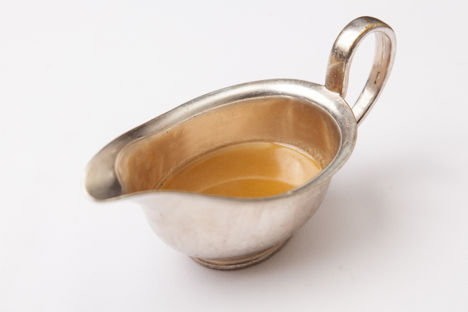A classic gravy is the combination of meat juices from the pan, thickened with a roux and extended with stock. Every cook has their own interpretation, and flavours can vary depending on the main joint or veg they are being served with, but one thing is certain, our toad in the hole and Sunday roast wouldn’t be the same without it.
Is there a formula for homemade gravy?
There are some very general ratios you can follow for making gravy from scratch – this is three parts flour, to two parts fat, to one part hot stock. The fat can be dripping and juices from your roast meat, butter or oil and is usually added to the pan first before working in the flour, followed by any veg or meat and your liquid and simmering to the right thickness.
What kind of stock is used in gravy?
The stock that you pour in the pan accounts for a lot of the flavour, so you want to use the best quality stock you can. Match the stock to the main ingredient in your meal eg for roast chicken use chicken stock, for a veggie main use veg stock etc. Veal stock is a great meat-based all-rounder which works for both richer red meat-friendly gravies and light poultry accompaniments. Check out our recipe for to make your own veal stock base for your gravy or chicken stock as an alternative for chicken gravy.
Do you have to use juices from roasted meat?
The easiest, and perhaps the most popular, way to make gravy is to do it in the same tin that the bird or joint of meat has just been roasted in. Simply thicken the meat juices with a bit of flour, vigorously stir out the lumps, and then extend with some stock enhanced with a splash of wine. However it is possible to make stock separately from your roast meat, if you are making it ahead of time. Follow this recipe for how:
Metric
Imperial
- 2 onions
- 2 carrots
- 2 celery, stalks
- 2 bay leaves
- 2 sprigs of thyme
- 1kg chicken wings
- 1 tbsp of olive oil
- 1 pinch of salt
- 2 pinches of freshly ground black pepper
- 4 tbsp of plain flour
Preheat the oven to 180C/160C fan. Roughly chop the veg then put in a flameproof roasting tin with the herbs and chicken. Drizzle with oil and season well with salt and pepper, then roast for 1 hour until tender and golden.
- 2 onions
- 2 carrots
- 2 celery, stalks
- 1 tbsp of olive oil
- 2 sprigs of thyme
- 2 bay leaves
- 1kg chicken wings
- 1 pinch of salt
- 2 pinches of freshly ground black pepper
Take the roasting tin out of the oven, stir everything to scrape up the sticky brown bits from the tin.
Stir in the flour and cook for 2 minutes. Then pour in 2 litres boiling water and simmer for 30 minutes until thickened
Strain the gravy through a sieve, mashing the ingredients into the sieve to extract the most flavour. Simmer again if you want to thicken your gravy further and stir in any flavourings you like, such as cranberry sauce, mustard or even a spoonful of creme fraiche.
If you want to make a beef gravy, follow this easy recipe for a step-by-step guide
What should I do if my gravy is too thin?
It is possible to thicken your gravy by bubbling it for longer. Or as a shortcut method you can add a small amount of what is called ‘slurry’, which is a combination of equal parts cornflour and water, whisk a little into your gravy and cook out for a few minutes until the gravy is thickened, but be careful not to add too much as this can impede the flavour of your gravy.
What shall I flavour my gravy with?
It's common to flavour poultry stock with a squeeze of lemon, but a flick of mustard, splash of tarragon vinegar, or a dollop of crème fraîche to lighten a gravy are all options. For darker, richer gravies a splash of red wine, port or Worcestershire sauce, and even a spoonful of marmite, can all amp up the umami flavour. Try our recipe for Garlic gravy, served with poutine or a wonderfully spiced Tandoori gravy to serve with marinated beef
How do I make vegetarian gravy?
You can make veggie gravy using base ingredients such as onion or mushrooms. For our guide to how to make the best no-meat gravy check out our guide
How can I keep my gravy warm?
Leave your gravy in the pan right up until the moment you are ready to serve. Another good tip is to fill your gravy boat with just boiled water from the kettle 5-10 minutes before you’re ready to plate up. This will warm up your gravy jug while you finish serving, and ensure your gravy stays hot for longer once you have emptied out the water and decanted your gravy into the boat.
How long does gravy keep in the fridge and freezer?
Once cooled, gravy keeps well, chilled in the fridge for up to 3 days. If you want to use it at a later date you can freeze gravy for up to 4 months. Defrost it fully before reheating to use.
Get in touch
Please sign in or register to send a comment to Great British Chefs.


